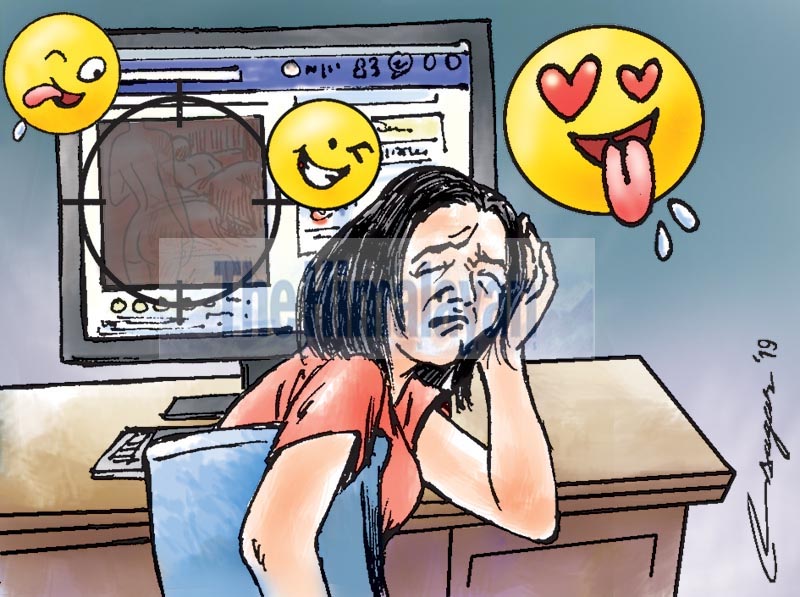Online sexism: Challenges of tackling it
Combatting online sexism is not merely about protecting women and making the internet a safe haven, it is also making men believe that they are not entitled to women’s sexual attention online or ‘offline’
Nepal is witnessing one of the most successful adoptions of digital technologies in the South Asian region. Easy access to the internet has enabled many people, particularly women and minority groups, to participate in the public sphere. The plurality of voices is one of the key indicators of prosperity. However, women are facing sexism and harassment via Facebook comments, YouTube videos and across all social media platforms. If we look into online harassment as a global problem, there are also cases of male victims, but the problem overwhelmingly affects women in a patriarchal society. While men experience name-calling and physical threats, women are much more likely to experience severe types of sexual harassment.
Digital platforms, including social networking sites, can be essential to address social injustices even gender inequality, abuse and the harassment faced ‘offline’. With the recent #MeToo movements, more people are holding discussions around the topics of gender inequality, sexism and misogyny. Still, the inequalities of Nepali society that were structuring ‘offline’ has been transferred online in different names like ‘online misogyny’, ‘cyberbullying’, ‘digital harassment’, ‘online sexism’, among others.
There have been limited scientific studies to conclude that misogyny has increased after the internet era. Nevertheless, it may be contended that the digital space has facilitated, if not amplified, misogynistic behaviours. From comments on news stories to Facebook posts to YouTube videos and memes, misogyny on the internet has taken many faces.
It may be argued that issues of gender trolling, online abuse are a ‘first-world’ problem, and a country like Nepal has many other gender-related issues to address. While we continue to face several gender-based discriminations, these problems being replicated online cannot be ignored.
News stories about female public figures, or any social media post, challenging gender stereotypes are often bombarded with sexist slurs. A few weeks ago, there was a news story on the gender pay gap in the Nepali movie industry in a leading Nepali newspaper. The story was also shared on the newspaper’s Facebook page. There were 14 comments on my Facebook News Feed. To my surprise, 12 out of the 14 comments were misogynistic. One of the commenters questioned, “...why should female actors be paid when they were not taking up important roles in the cinemas?” The comment is somewhat biased from the feminist perspective, but at least it opens up an avenue for further discussion. Another commenter stated, “Why should they (female actors) be paid more when they are making more money during nights?” Another commenter also lumped prostitution and acting together. While there exist a diversity of feminist views on prostitution, commenters’ intention here was to degrade the hard work and efforts of Nepali film actors because of their gender.
As we continue to spend more time online, what happens in the comment section of a Facebook post or Twitter thread can have severe implications in our lives. The psychological harm caused by online harassment is as severe as harassment endured in the physical world. These sorts of harassments also come with socio-economic impacts, when women quit work. The fear connected with online-based abuse and hatred is slowly weakening women’s ability to act, speak and to engage.
Part of the problem is that Nepali culture largely sees men’s sexism as something innate rather than deviant. Eve teasing, sexist jokes and even domestic violence up to some extent are culturally accepted. In our society where sexism is deemed “normal”, the sexist comments will keep coming. So, what is the way out then?
While women from all walks of lives are affected by online misogyny, journalists, politicians and celebrities are facing daily harassment because of the nature of their work, which requires internet presence. Therefore, media organisations, political parties and the government have an important role to play in discouraging these practices.
The anonymity nature of the internet has been often cited as one of the major challenges in combatting online sexism. To my surprise, my quick research on the comments revealed that none of these accounts were ‘fake’. The challenge of tackling online abuse in Nepal’s context is that many are unaware that it exists. Therefore, sensitisation of the issues, media coverage on online-based abuses is necessary. Most social networking sites have a ‘report abuse’ or a similar button that can be used to report harassments.
It is commendable that mainstream newspapers in Nepal are online and have an active presence on social media. However, they are not acting in a timely or consistent manner when it comes to addressing sexist and hateful comments.
Combatting online sexism is not merely about protecting women and making the internet a safe haven, it is also making men believe that they are not entitled to women’s sexual attention online or ‘offline’. Social networking sites present us with an opportunity to network, organise and campaign. The same technology should be used to resist violence and fight back against abuse, but not to inflict pain.
Koirala holds a PhD in journalism from University of Oslo, Norway






